Modified “Rockfall Hazard Rating System for Pakistan (RHRSP)”: An Application for Hazard and Risk Assessment along the Karakoram Highway, Northwest Pakistan
Abstract
:1. Introduction
2. Materials and Methods
2.1. Rockfall Hazard Rating System (RHRS)
2.1.1. Topographic Factors
2.1.2. Geologic/Structural Factors
2.1.3. Influencing Factors
2.1.4. Rock Failure
2.1.5. Road Specifications
2.2. Modified Rockfall Hazard Rating System for Pakistan (RHRSP)
2.2.1. An Overview of Rockfall Activity through Animals
2.2.2. Quantification of Animal Activity
3. Application of Modified Rockfall Hazard Rating System
3.1. Study Area
3.2. Geological Settings
3.3. Slope Variation in Study Area
3.4. Rockfall Inventoy
4. Results and Discussion
4.1. Assessment of Potential Rockfall Sites
4.1.1. Rockfall at Besham
4.1.2. Rockfall at Dubair
4.1.3. Rockfall at Jijal
4.1.4. Rockfall from Jijal to Dasu
4.2. Geostructural Interpretation
4.3. Rockfall Hazard Assessment
4.4. Rockfall Risk Assessment
4.5. A Comparative Assessment with Similar Studies
5. Conclusions
- The standard RHRS system has been modified to quantify animal activity that is responsible for causing rockfall triggering in the mountainous terrain of Pakistan. The modified model will be known as the Rockfall Hazard Rating System for Pakistan (RHRSP).
- The quantifying parameters of animal activity are grazing altitude, shoulder width of road, random and permanent animal tracks, and slope steepness. A minimum score will be assigned to a condition when the slope is gentle and there is a minimum chance of falling stones reaching the ground. Conversely, the highest scores will be assigned when falling stone from steep slopes directly reach a road with no shoulder width.
- From the kinematic analysis of rockfalls at 30 stations, it is observed that rockfall failures are mostly of the wedge and topple types associated with steep hard rock cliffs. Fifty-seven percent of the highway falls under very-high and high hazard zones, specifically between Jijal and Pattan villages, and 18% of the moderate hazard zone is distributed throughout the entire stretch. The low–very-low hazard zone is mainly present between Besham and Dubair, covering 25% of the entire stretch. This low–very-low hazard area is most likely due to the gentle slope, lower population, and limited animal activity at altitude.
- Sixty-seven percent of the entire stretch is under moderate to high and very-high risk between Dubair and Dasu due to narrow road width, limited shoulder width, deep gorges, and insufficient protection measures.
- Interpretation of conjugate fracture set data through stereographic projection shows that stations 2–7, located within the core zone of Indus syntaxis, indicate the dominance of lateral (strike-slip) stresses due to a syntaxial bend. The rest of the stations are divided into four minor groups i.e., 8–13, 14–18, 19–21, and 22–30. Stations 8, 11, 12, and 13 show northeast–southwest directed thrusting, which matches the region’s regional northeast–southwest compression. Stations 9 and 10 show extensional dominance associated with local folding. From stations 14–21, strike-slip and compressional stresses are accompanied by the composite impact of thrusting, extension, and strike-slip components. Stations 22, 24, and 28 show north-northeast–south-southwest and northwest–southeast directed thrusting dominance. Stations 25, 26, 29, and 30 depict strike slip components, whereas stations 23 and 27 show the dominant extensional component.
- This stress variation observed along the entire stretch suggests that this region has complex tectonic architecture, which caused severe deformation in the rocks in the form of fracturing and shearing, ultimately supporting the failure in the form of rockfall toppling and rockslides.
Author Contributions
Funding
Institutional Review Board Statement
Informed Consent Statement
Data Availability Statement
Conflicts of Interest
References
- Pierson, L.A.; Davis, S.A.; van Vickle, R. Rockfall Hazard Rating System: Implementation Manual; Federal Highway Administration: Washington, DC, USA, 1990. [Google Scholar]
- Guzzetti, F.; Reichenbach, P.; Ghigi, S. Rockfall hazard and risk assessment along a transportation corridor in the Nera Valley, Central Italy. Environ. Manag. 2004, 34, 191–208. [Google Scholar] [CrossRef]
- Zhou, J.-W.; Jiao, M.-Y.; Xing, H.-G.; Yang, X.-G.; Yang, Y.-C. A reliability analysis method for rock slope controlled by weak structural surface. Geosci. J. 2017, 21, 453–467. [Google Scholar] [CrossRef]
- Varnes, D.J. Slope movement types and processes. Spec. Rep. 1978, 176, 11–33. [Google Scholar]
- Wyllie, D. Toppling rock slope failures: Examples of analysis and stabilization. Rock Mech. 1980, 13, 89–98. [Google Scholar] [CrossRef]
- Collins, B.D.; Stock, G.M. Rockfall triggering by cyclic thermal stressing of exfoliation fractures. Nat. Geosci. 2016, 9, 395. Available online: https://www.nature.com/articles/ngeo2686#supplementary-information (accessed on 14 August 2021). [CrossRef]
- Cruden, D.M.; Varnes, D.J. Landslides: Investigation and mitigation. Chapter 3-Landslide types and processes. Transp. Res. Board Spec. Rep. 1996, 247, 36–75. [Google Scholar]
- Field, C.B.; Barros, V.; Stocker, T.F.; Dahe, Q. Managing the Risks of Extreme Events and Disasters to Advance Climate Change Adaptation: Special Report of the Intergovernmental Panel on Climate Change; Cambridge University Press: Cambridge, UK, 2012. [Google Scholar]
- Budetta, P.; De Luca, C.; Nappi, M. Quantitative rockfall risk assessment for an important road by means of the rockfall risk management (RO. MA.) method. Bull. Eng. Geol. Environ. 2016, 75, 1377–1397. [Google Scholar] [CrossRef]
- Budetta, P.; Nappi, M. Comparison between qualitative rockfall risk rating systems for a road affected by high traffic intensity. Nat. Hazards Earth Syst. Sci. 2013, 13, 1643–1653. [Google Scholar] [CrossRef] [Green Version]
- Ferrari, F.; Giacomini, A.; Thoeni, K. Qualitative rockfall hazard assessment: A comprehensive review of current practices. Rock Mech. Rock Eng. 2016, 49, 2865–2922. [Google Scholar] [CrossRef]
- Ferrari, F.; Giacomini, A.; Thoeni, K.; Lambert, C. Qualitative evolving rockfall hazard assessment for highwalls. Int. J. Rock Mech. Min. Sci. 2017, 98, 88–101. [Google Scholar] [CrossRef]
- Ferrero, A.M.; Migliazza, M.R.; Pirulli, M.; Umili, G. Some open issues on rockfall hazard analysis in fractured rock mass: Problems and prospects. Rock Mech. Rock Eng. 2016, 49, 3615–3629. [Google Scholar] [CrossRef]
- Li, X.-N.; Ling, S.-X.; Sun, C.-W.; Xu, J.-X.; Huang, T. Integrated rockfall hazard and risk assessment along highways: An example for Jiuzhaigou area after the 2017 Ms 7.0 Jiuzhaigou earthquake, China. J. Mt. Sci. 2019, 16, 1318–1335. [Google Scholar] [CrossRef]
- Mignelli, C.; Lo Russo, S.; Peila, D. ROckfall risk MAnagement assessment: The RO. MA. approach. Nat. Hazards 2012, 62, 1109–1123. [Google Scholar] [CrossRef]
- Regmi, A.D.; Cui, P.; Dhital, M.R.; Zou, Q. Rock fall hazard and risk assessment along Araniko Highway, Central Nepal Himalaya. Environ. Earth Sci. 2016, 75, 1–20. [Google Scholar] [CrossRef]
- Mavrouli, O.-C.; Abbruzzese, J.; Corominas, J.; Labiouse, V. Review and advances in methodologies for rockfall hazard and risk assessment. In Mountain Risks: From Prediction to Management and Governance; Springer: Berlin/Heidelberg, Germany, 2014; pp. 179–199. [Google Scholar]
- Cruden, D.M.; Fell, R. Quantitative risk assessment for slopes and landslides—The state of the art: IUGS Working Group on Landslides, Committee on Risk Assessment. In Landslide Risk Assessment; Routledge: London, UK, 1997; pp. 3–12. [Google Scholar]
- Maerz, N.H.; Youssef, A.M.; Pradhan, B.; Bulkhi, A. Remediation and mitigation strategies for rock fall hazards along the highways of Fayfa Mountain, Jazan Region, Kingdom of Saudi Arabia. Arab. J. Geosci. 2015, 8, 2633–2651. [Google Scholar] [CrossRef]
- Machinskaya, R.I.; Krupskaya, E.V.; Kurgansky, A.V. Debris-flow mobilization from landslides. Annu. Rev. Earth Planet. Sci. 1997, 25, 85–138. [Google Scholar]
- Mineo, S. Comparing rockfall hazard and risk assessment procedures along roads for different planning purposes. J. Mt. Sci. 2020, 17, 653–669. [Google Scholar] [CrossRef]
- Pierson, L.A.; van Vickle, R. Rockfall Hazard Rating System: Participant’s Manual; Federal Highway Administration: Washington, DC, USA, 1993. [Google Scholar]
- Brawner, C.; Wyllie, D. Rock slope stability on railway projects. Area Bull. 1976, 77, 449–474. [Google Scholar]
- Pritchard, M.; Porter, M.; Savigny, W.; Bruce, I.; Oboni, F.; Keegan, T.; Abbott, B. CN Rockfall Hazard Risk Management System: Experience, Enhancements, and Future Direction; The American Railway Engineering and Maintenance-of-Way Association: Chicago, IL, USA, 2005. [Google Scholar]
- Maerz, N.H.; Youssef, A.; Fennessey, T.W. New risk–consequence rockfall hazard rating system for Missouri highways using digital image analysis. Environ. Eng. Geosci. 2005, 11, 229–249. [Google Scholar] [CrossRef]
- Santi, P.M.; Russell, C.P.; Higgins, J.D.; Spriet, J.I. Modification and statistical analysis of the Colorado Rockfall Hazard Rating System. Eng. Geol. 2008, 104, 55–65. [Google Scholar] [CrossRef]
- Budetta, P. Assessment of rockfall risk along roads. Nat. Hazards Earth Syst. Sci. 2004, 4, 71–81. [Google Scholar] [CrossRef] [Green Version]
- Ulamış, K.; Kılıç, R. Combined instability assessment and rockfall hazard in volcanic rocks (Keçiören, Ankara). Arab. J. Geosci. 2020, 13, 349. [Google Scholar] [CrossRef]
- Searle, M.; Khan, M.A.; Fraser, J.; Gough, S.; Jan, M.Q. The tectonic evolution of the Kohistan-Karakoram collision belt along the Karakoram Highway transect, North Pakistan. Tectonics 1999, 18, 929–949. [Google Scholar] [CrossRef] [Green Version]
- Petley, D. Landslide damage to the Karakoram Highway. Available online: https://blogs.agu.org/landslideblog/2016/04/13/karakoram-highway-1 (accessed on 15 January 2020).
- Ali, S.; Haider, R.; Abbas, W.; Basharat, M.; Reicherter, K. Empirical assessment of rockfall and debris flow risk along the Karakoram Highway, Pakistan. Nat. Hazards 2021, 106, 2437–2460. [Google Scholar] [CrossRef]
- Farvacque, M.; Lopez-Saez, J.; Corona, C.; Toe, D.; Bourrier, F.; Eckert, N. Quantitative risk assessment in a rockfall-prone area: The case study of the Crolles municipality (Massif de la Chartreuse, French Alps). Géomorphologie Relief Processus Environ. 2019, 25, 7–19. [Google Scholar] [CrossRef]
- Guzzetti, F.; Reichenbach, P.; Wieczorek, G. Rockfall hazard and risk assessment in the Yosemite Valley, California, USA. Nat. Hazards Earth Syst. Sci. 2003, 3, 491–503. [Google Scholar] [CrossRef] [Green Version]
- Michoud, C.; Derron, M.-H.; Horton, P.; Jaboyedoff, M.; Baillifard, F.-J.; Loye, A.; Nicolet, P.; Pedrazzini, A.; Queyrel, A. Rockfall hazard and risk assessments along roads at a regional scale: Example in Swiss Alps. Nat. Hazards Earth Syst. Sci. 2012, 12, 615–629. [Google Scholar] [CrossRef] [Green Version]
- Mineo, S.; Pappalardo, G.; Mangiameli, M.; Campolo, S.; Mussumeci, G. Rockfall analysis for preliminary hazard assessment of the cliff of Taormina Saracen Castle (Sicily). Sustainability 2018, 10, 417. [Google Scholar] [CrossRef] [Green Version]
- Regmi, A.D.; Dhital, M.R.; Zhang, J.-Q.; Su, L.-J.; Chen, X.-Q. Landslide susceptibility assessment of the region affected by the 25 April 2015 Gorkha earthquake of Nepal. J. Mt. Sci. 2016, 13, 1941–1957. [Google Scholar] [CrossRef]
- Saroglou, H.; Marinos, V.; Marinos, P.; Tsiambaos, G. Rockfall hazard and risk assessment: An example from a high promontory at the historical site of Monemvasia, Greece. Nat. Hazards Earth Syst. Sci. 2012, 12, 1823–1836. [Google Scholar] [CrossRef] [Green Version]
- Omran, A.; Fahmida, K.; Schröder, D.; Arnous, M.O.; El-Rayes, A.E.; Hochschild, V. GIS-based rockfall hazard zones modeling along the coastal Gulf of Aqaba Region, Egypt. Earth Sci. Inform. 2021, 14, 691–709. [Google Scholar] [CrossRef]
- Sjöberg, J. Analysis of Large Scale Rock Slopes. Ph.D. Thesis, Luleå Tekniska Universitet, Luleå, Sweden, 1999. [Google Scholar]
- Hack, R.; Alkema, D.; Kruse, G.A.; Leenders, N.; Luzi, L. Influence of earthquakes on the stability of slopes. Eng. Geol. 2007, 91, 4–15. [Google Scholar] [CrossRef]
- Zaman, S.; Ornthammarath, T.; Warnitchai, P. Probabilistic seismic hazard maps for Pakistan. In Proceedings of the 15th World Conference on Earthquake Engineering, Lisbon, Portugal, 24–28 September 2012; pp. 1–10. [Google Scholar]
- Keefer, D.K. Landslides caused by earthquakes. Geol. Soc. Am. Bull. 1984, 95, 406. [Google Scholar] [CrossRef]
- Ruskin, J. Modern Painters.-5 Vol; J. Wiley & Sons: Hoboken, NJ, USA, 1866; Volume 3. [Google Scholar]
- McCauley, M.; Works, B.; Naramore, S. Rockfall Mitigation—Final Report (FHWA/CA/TL-85/12); FHWA: Washington, DC, USA, 1985. [Google Scholar]
- Dorren, L.K. A review of rockfall mechanics and modelling approaches. Prog. Phys. Geogr. 2003, 27, 69–87. [Google Scholar] [CrossRef]
- Partsinevelos, P.; Kritikakis, G.; Economou, N.; Agioutantis, Z.; Tripolitsiotis, A.; Mertikas, S.; Vafidis, A. Integration of seismic and image data processing for rockfall monitoring and early warning along transportation networks. Nat. Hazards 2016, 83, 133–153. [Google Scholar] [CrossRef]
- Macciotta, R.; Martin, C.D.; Edwards, T.; Cruden, D.M.; Keegan, T. Quantifying weather conditions for rock fall hazard management. Georisk Assess. Manag. Risk Eng. Syst. Geohazards 2015, 9, 171–186. [Google Scholar] [CrossRef]
- Ahmad, M.; Umrao, R.K.; Ansari, M.K.; Singh, R.; Singh, T.N. Assessment of Rockfall Hazard along the Road Cut Slopes of State Highway-72, Maharashtra, India. Geomaterials 2013, 3, 15–23. [Google Scholar] [CrossRef] [Green Version]
- Luckman, B. 7.17 Processes, Transport, Deposition, and Landforms: Rockfall. Treatise Geomorphol. 2013, 7, 174–182. [Google Scholar] [CrossRef]
- Froude, M.J.; Petley, D.N. Global fatal landslide occurrence from 2004 to 2016. Nat. Hazards Earth Syst. Sci. 2018, 18, 2161–2181. [Google Scholar] [CrossRef] [Green Version]
- Tahirkheli, R.K. Geology of Kohistan and adjoining Eurasian and Indo-Pakistan continents, Pakistan. Geol. Bull. Univ. Peshawar 1979, 11, 1–30. [Google Scholar]
- Shah, A.A.; Ye, J.; Abid, M.; Khan, J.; Amir, S.M. Flood hazards: Household vulnerability and resilience in disaster-prone districts of Khyber Pakhtunkhwa province, Pakistan. Nat. Hazards 2018, 93, 147–165. [Google Scholar] [CrossRef]
- Jade, S.; Bhatt, B.; Yang, Z.; Bendick, R.; Gaur, V.; Molnar, P.; Anand, M.; Kumar, D. GPS measurements from the Ladakh Himalaya, India: Preliminary tests of plate-like or continuous deformation in Tibet. Geol. Soc. Am. Bull. 2004, 116, 1385–1391. [Google Scholar] [CrossRef]
- Bhatti, Z.I.; Zhao, J.; Khan, N.G.; Shah, S.T.H. Structure of crust and upper mantle beneath NW Himalayas, Pamir and Hindukush by multi-scale double-difference seismic tomography. Phys. Earth Planet. Inter. 2018, 281, 92–102. [Google Scholar] [CrossRef]
- Ding, L.; Qasim, M.; Jadoon, I.A.; Khan, M.A.; Xu, Q.; Cai, F.; Wang, H.; Baral, U.; Yue, Y. The India—Asia collision in north Pakistan: Insight from the U-Pb detrital zircon provenance of Cenozoic foreland basin. Earth Planet. Sci. Lett. 2016, 455, 49–61. [Google Scholar] [CrossRef] [Green Version]
- Guzzetti, F.; Mondini, A.C.; Cardinali, M.; Fiorucci, F.; Santangelo, M.; Chang, K.T. Landslide inventory maps: New tools for an old problem. Earth-Sci. Rev. 2012, 112, 42–66. [Google Scholar] [CrossRef] [Green Version]
- Westen, C.J.V.; Castellanos, E.; Kuriakose, S.L. Spatial data for landslide susceptibility, hazard, and vulnerability assessment: An overview. Eng. Geol. 2008, 102, 112–131. [Google Scholar] [CrossRef]
- Rashid, B.; Iqbal, J.; Su, L.-J. Landslide susceptibility analysis of Karakoram highway using analytical hierarchy process and scoops 3D. J. Mt. Sci. 2020, 17, 1596–1612. [Google Scholar] [CrossRef]
- Ali, S.; Schneiderwind, S.; Reicherter, K. Structural and Climatic Control of Mass Movements Along the Karakoram Highway. In Proceedings of the Workshop on World Landslide Forum, Ljubljana, Slovenia, 30 May–2 June 2017; pp. 509–516. [Google Scholar]
- Ali, S.; Biermanns, P.; Haider, R.; Reicherter, K. Landslide susceptibility mapping by using a geographic information system (GIS) along the China–Pakistan Economic Corridor (Karakoram Highway), Pakistan. Nat. Hazards Earth Syst. Sci. 2019, 19, 999–1022. [Google Scholar] [CrossRef] [Green Version]
- Ali, S.; Tayyib Riaz, M.; Sarfraz, Y.; Shafique, M.; Basharat, M.; Reicherter, K. Rock Fall and Debris Flow Hazard and Risk Assessment along Karakoram Highway (Besham-Chilas Section), Pakistan; EGUGA: Viena, Austria, 2018; p. 6974-2. [Google Scholar]
- Ahmed, M.F. A regional study of landslide hazards and related features in the Upper Indus River Basin, Northern Pakistan; Missouri University of Science and Technology: Rolla, MO, USA, 2013. [Google Scholar]
- Corominas, J.; van Westen, C.; Frattini, P.; Cascini, L.; Malet, J.-P.; Fotopoulou, S.; Catani, F.; Van Den Eeckhaut, M.; Mavrouli, O.; Agliardi, F. Recommendations for the quantitative analysis of landslide risk. Bull. Eng. Geol. Environ. 2014, 73, 209–263. [Google Scholar] [CrossRef]
- Hubbard, D.W. The Failure of Risk Management: Why it’s Broken and How to Fix It; John Wiley & Sons: Hoboken, NJ, USA, 2020. [Google Scholar]
- Sakız, U.; Geniş, M.; Bilir, M.E.; Sakız, P. Rockfall analysis and risk assessment on steep slopes of the roadway (Zonguldak, Turkey). Arab. J. Geosci. 2021, 14, 1–12. [Google Scholar] [CrossRef]
- Vishal, V.; Siddique, T.; Purohit, R.; Phophliya, M.K.; Pradhan, S. Hazard assessment in rockfall-prone Himalayan slopes along National Highway-58, India: Rating and simulation. Nat. Hazards 2017, 85, 487–503. [Google Scholar] [CrossRef]
- Bozdağ, A. Rockfall hazard assessment in a natural and historical site: The case of ancient Kilistra settlement (Konya), Turkey. J. Mt. Sci. 2022, 19, 151–166. [Google Scholar] [CrossRef]
- Topal, T.; Akin, M.; Ozden, U.A. Assessment of rockfall hazard around Afyon Castle, Turkey. Environ. Geol. 2007, 53, 191–200. [Google Scholar] [CrossRef]
- Fanos, A.M.; Pradhan, B.; Alamri, A.; Lee, C.-W. Machine learning-based and 3d kinematic models for rockfall hazard assessment using LiDAR data and GIS. Remote Sens. 2020, 12, 1755. [Google Scholar] [CrossRef]
- Fell, R.; Corominas, J.; Bonnard, C.; Cascini, L.; Leroi, E.; Savage, W.Z. Guidelines for landslide susceptibility, hazard and risk zoning for land use planning. Eng. Geol. 2008, 102, 85–98. [Google Scholar] [CrossRef] [Green Version]
- Wyllie, D. Risk management of rock fall hazards. In Proceedings of the Canadian Geotechnical Society Annual Conference, Vancouver, BC, Canada, 2005. [Google Scholar]


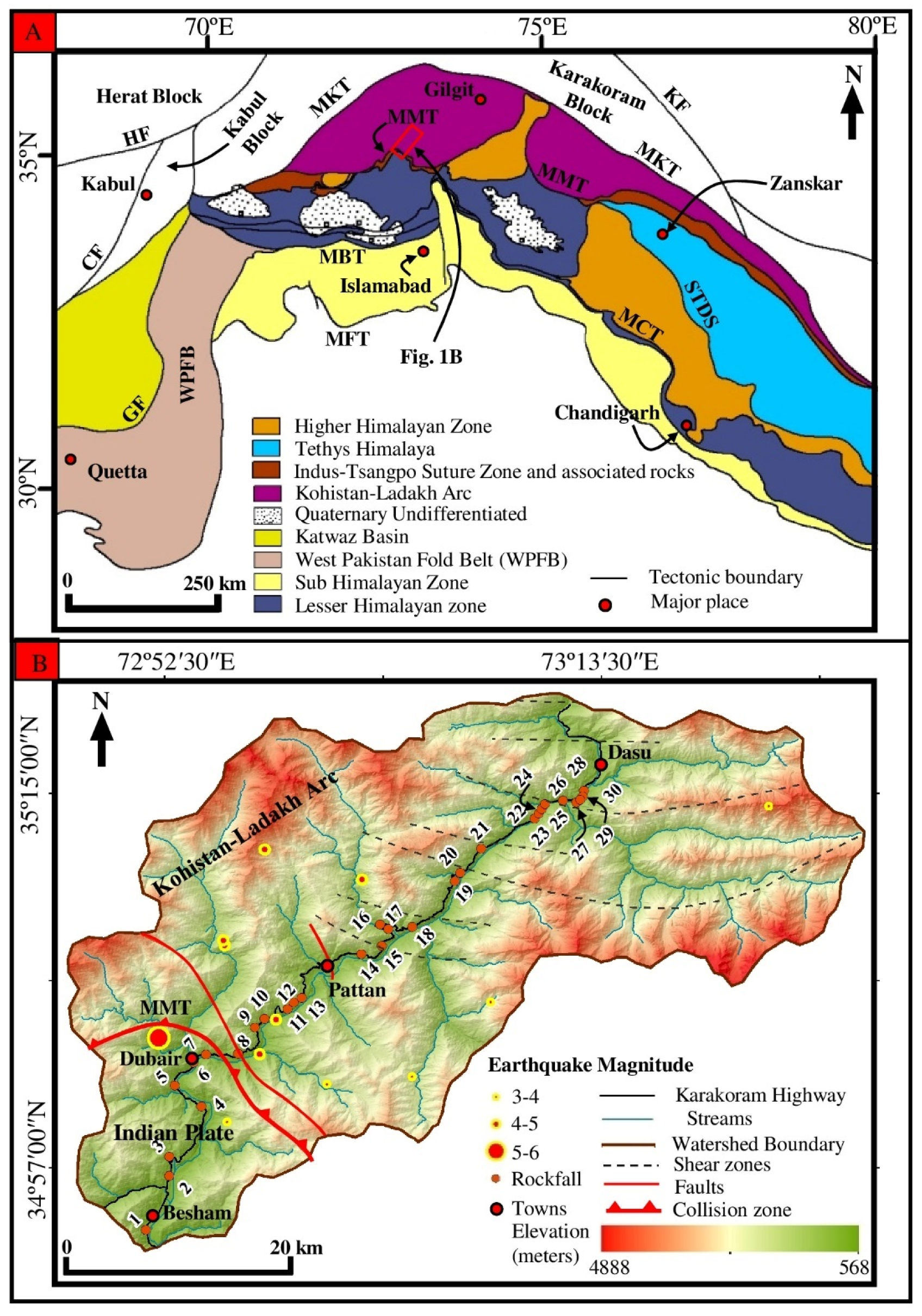

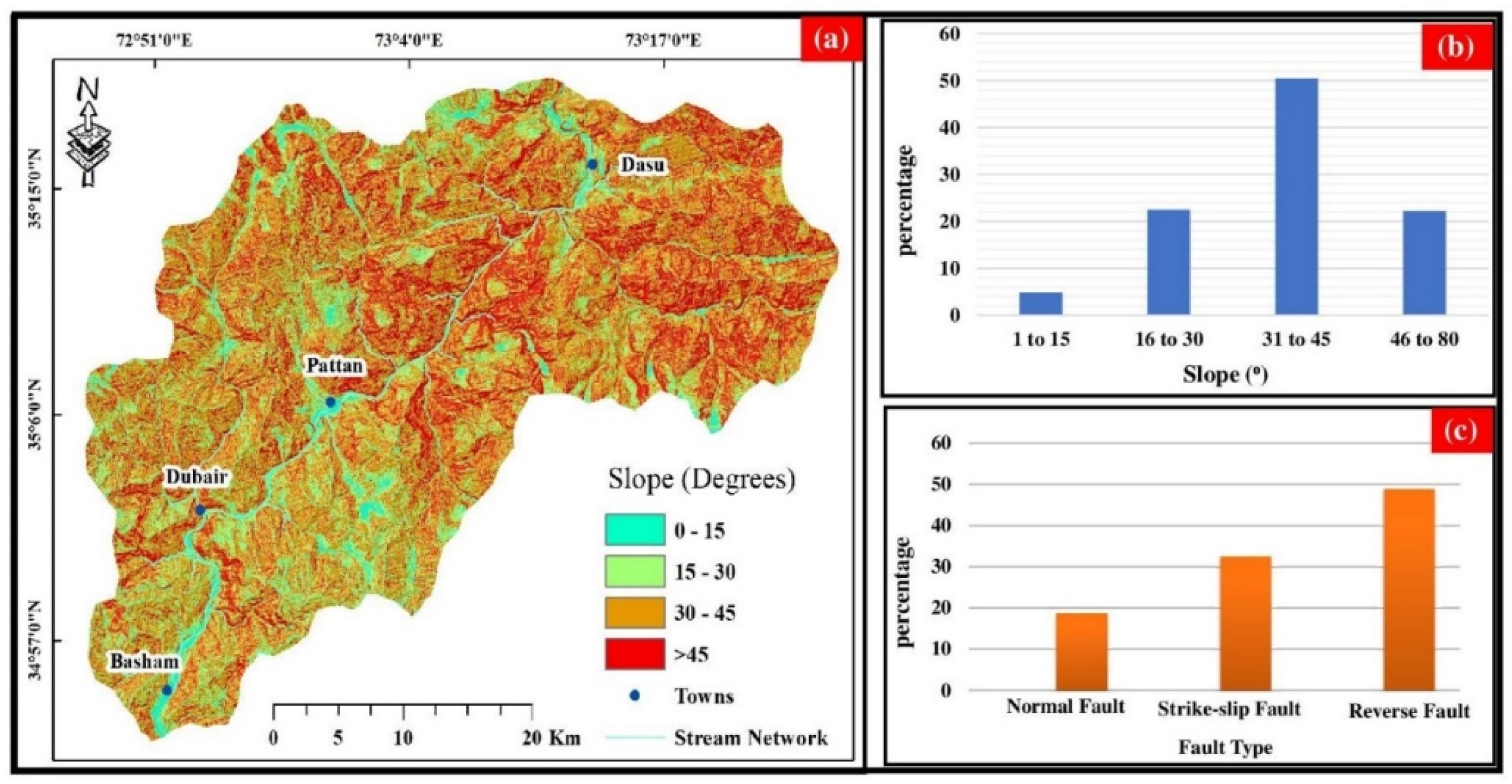

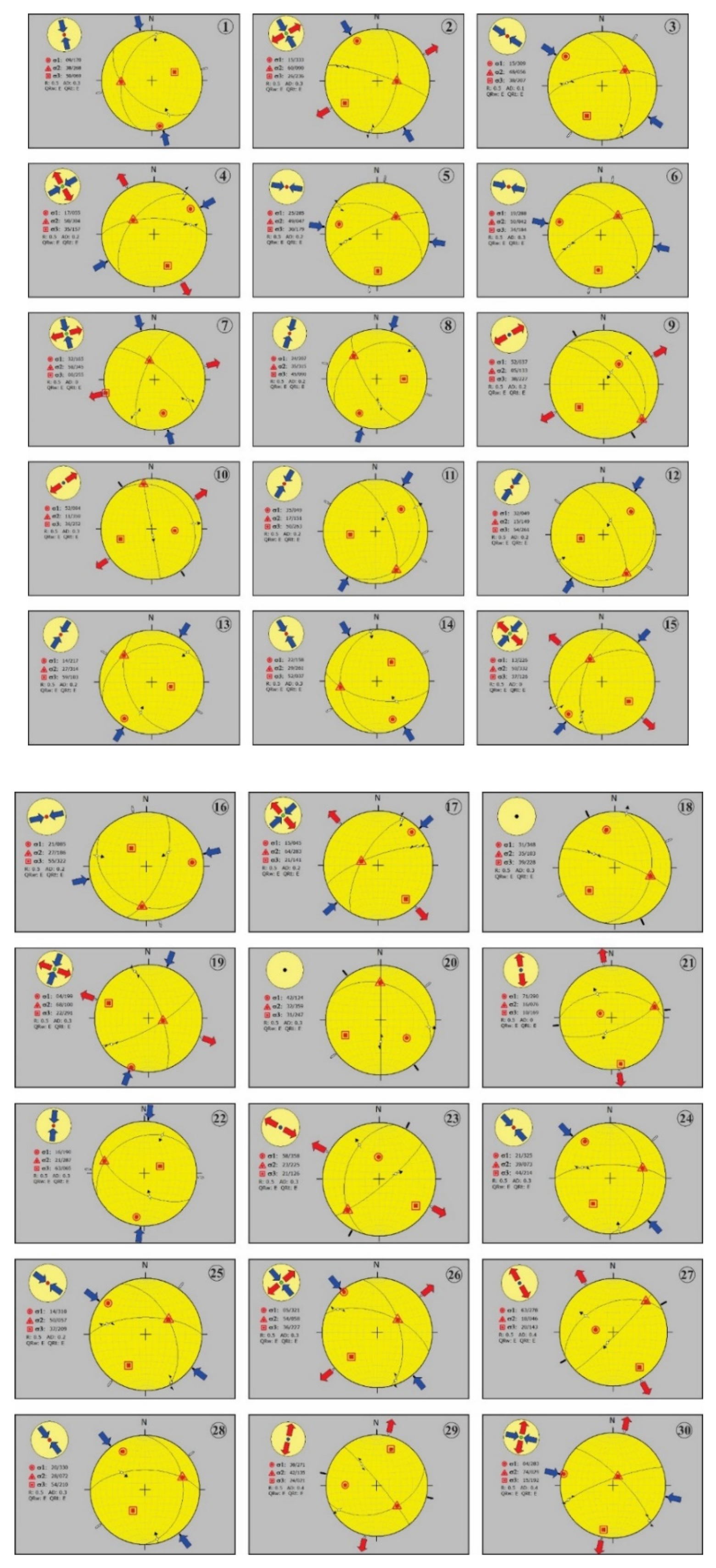
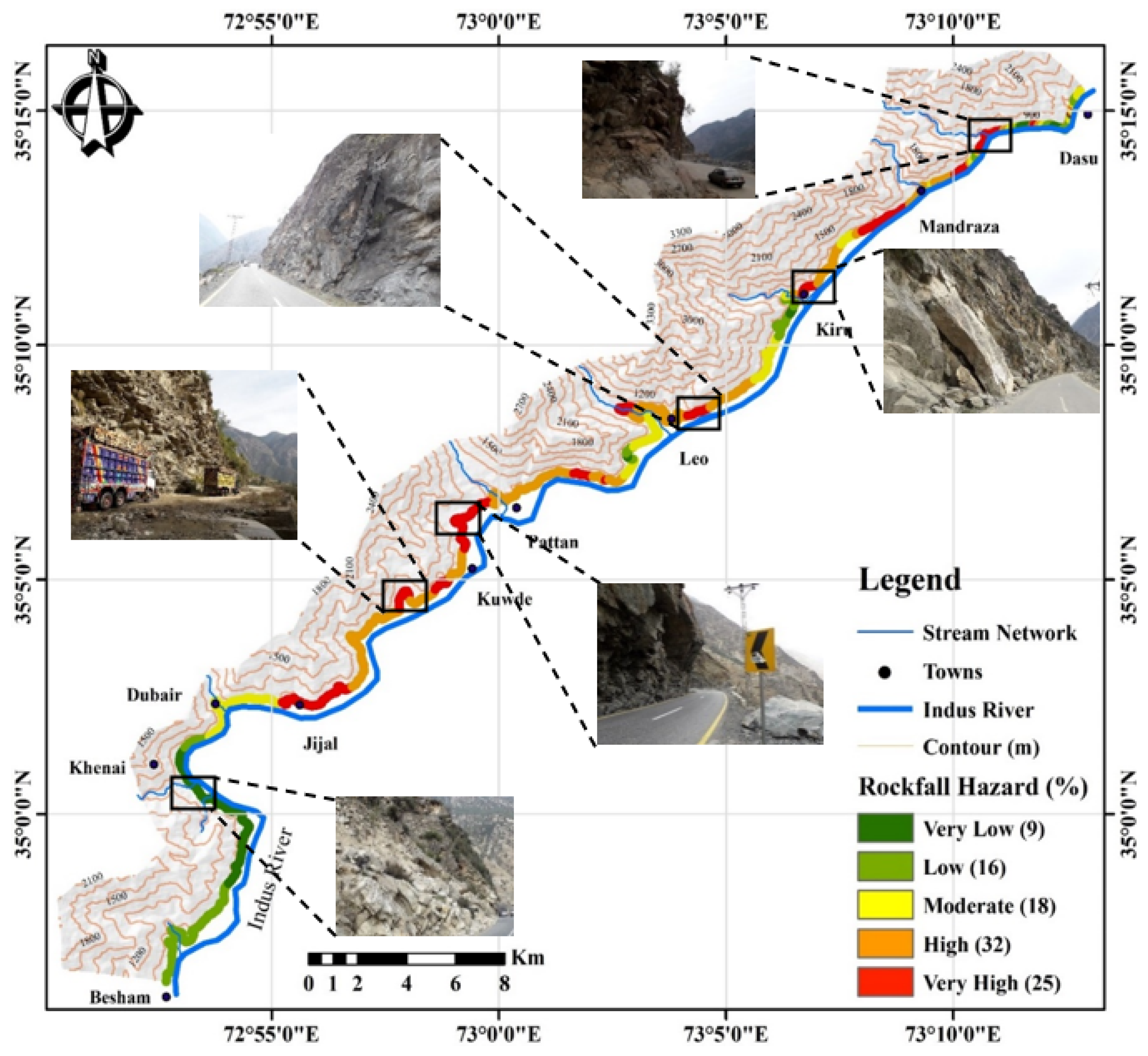
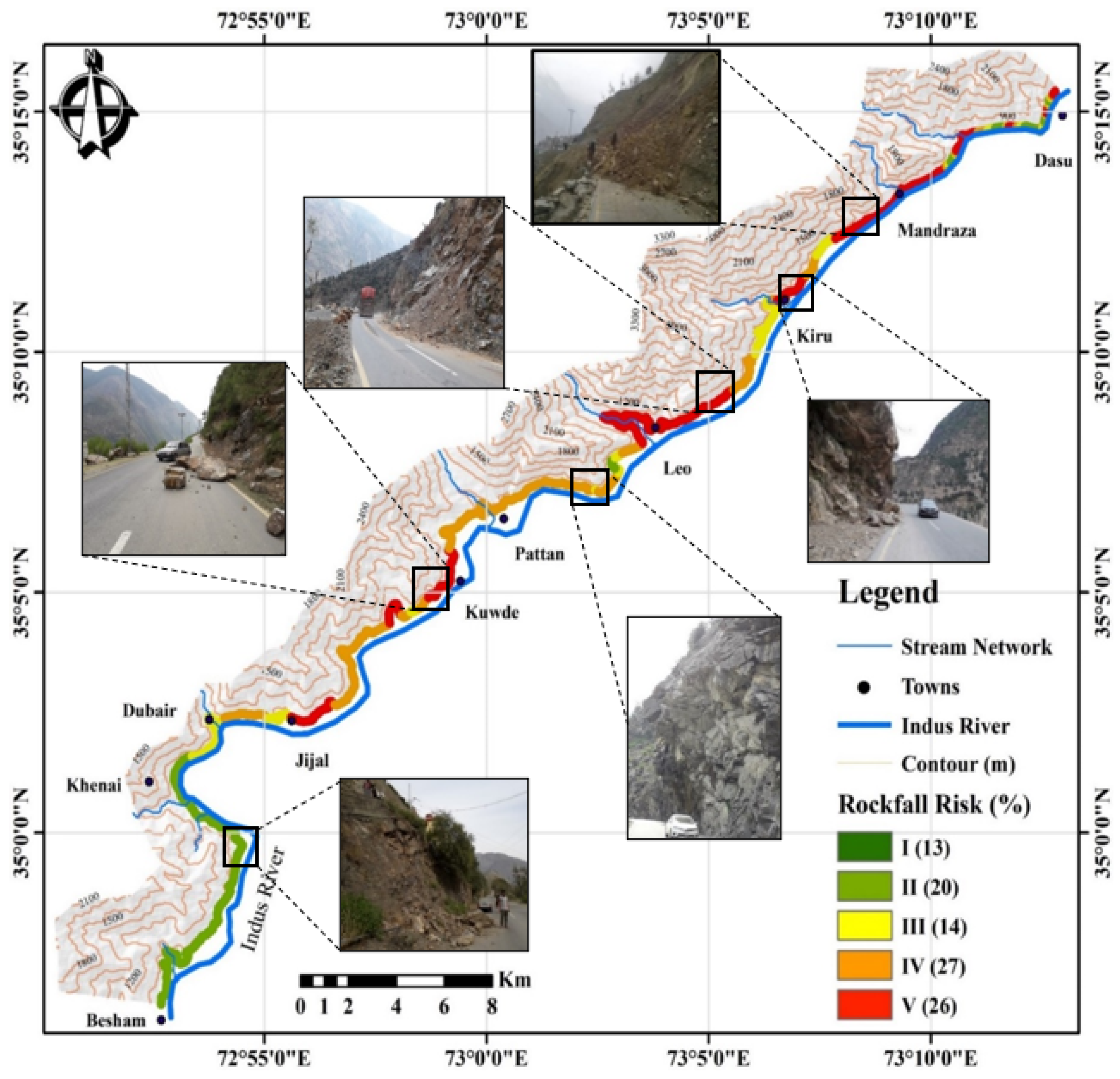
| Category | Rating Criteria by Score | |||||
|---|---|---|---|---|---|---|
| Points 3 | Points 9 | Points 27 | Points 81 | |||
| Slope Height (m) | 7.5 | 16 | 25 | >30 | ||
| Ditch Effectiveness | Good catchment | Moderate catchment | Limited catchment | No catchment | ||
| Average Vehicle Risk (% of time) | 25% | 50% | 75% | 100% | ||
| Percentage of Decision Sight distance | Adequate 100% | Moderate 80% | Limited 60% | Very Limited 40% | ||
| Geologic condition | Case one | Structural Condition | Discontinuous joints, favorable orientation | Discontinuous jointsrandom, orientation | Discontinuous joints, adverse orientation | continuous joints, adverse orientation |
| Rock Friction | Rough, irregular | Undulating | Planar | Clay infilling, or slickensided | ||
| Case two | Structural Condition | Few differential erosion features | Occasional differential erosion features | Many differential erosion features | Major differential erosion features | |
| Difference in erosion rates | Small | Moderate | Large | Extreme | ||
| Block Size (m3) Volume of rockfall (per event) | 0–0.25 3m3 | 0.25–0.5 5m3 | 0.5–1 7m3 | >1 10m3 | ||
| Climate and presence of water on slope | Low to moderate precipitation, no freezing periods, no water on slope | moderate precipitation or short freezing periods or intermittent water on slope | High precipitation or long freezing periods or continual water on slope and long freezing periods | High precipitation and long freezing periods or continual | ||
| Rockfall History | Few falls | Occasional falls | Many falls | Constant falls | ||
| 3 Points | 9 Points | 27 Points | 81 Points | ||
|---|---|---|---|---|---|
| HAZARD Topographic factors Geologic/Structural Factors | Slope Angle (°) | 0–15 | 15–30 | 30–45 | >45 |
| Slope height (m) | 15 to 50 | 50 to 100 | 100 to 200 | >200 | |
| Joints/Fractures orientation | No adversely oriented joints | Randomly oriented joints | Adverse orientation/Less than 10 feet length | Adverse orientation/greater than 10 feet length | |
| Joints spacing (m) | 0.2 or less | 0.2–0.5 | 0.5–1 | Greater than 1 | |
| Weathering | Fresh | Slight | Moderate | High | |
| Rock friction | Rough | Undulating | Planar | Clay infilling | |
| Suspended mass | Fine material | Fine/cobbles | Cobbles to boulders | Boulders | |
| Influencing factors Rock Failure | Water on slope | Dry slope | Moist | Continual water on slope | Flowing water on slope |
| Earthquake Intensity | 5 and lower | 5–6 | 6–7 | 7 and larger | |
| Animal activity | Grazing at shallow/higher altitudes with a gentle slope. Falling stones may or may not approach the road. | Grazing at permanent or random animal tracks at shallow/higher altitude with enough shoulder width to avoid stones from coming to the road | Grazing at permanent/random tracks at shallow/higher altitudes with very low shoulder width. Falling stones approach the road | Grazing at permanent/random tracks at shallow altitude with no shoulder width. Grazing very close to the road. Falling stones reach directly to the road | |
| Settlements/Population | None | At or below the highway | At lower altitude from highway and less populated | At Higher altitude and densely populated | |
| Rockfall History | Few Falls | Occasional Falls | Many Falls | Daily Falls | |
| Talus development | No fallen rock at toe | Few rock fragments or slides at toe | Scattered pile of fallen rock | Developed talus of rock/debris slide at either side of the road | |
| Size of fallen rocks (m3) | <0.5 | 0.5–1 | 11.5 | 1.5 and more | |
| Landcover | Vegetation cover | Scarce vegetation | Interlayering of hard and soft rock slope | No cover/Bare Hard Rock | |
| VULNERABILITY Road Specifications | Road width (m) | 13 | 10 | 7.5 | 3.5 |
| Shoulder width (m) | 4 | 2–4 | Less than 2 | No width | |
| Percent of Decision Sight distance | Adequate, 100% | Moderate, 80% | Limited, 60% | Very Limited, 40% | |
| Average vehicle at risk (% time) | 25% of time | 50% of time | 75% of time | 100% of time | |
| Ditch Effectiveness | Good catchment | Moderate catchment | Limited catchment | No catchment | |
| Protection measures | Completely protective | Few Protective measures | No Protection | Blasting and cutting slope | |
Publisher’s Note: MDPI stays neutral with regard to jurisdictional claims in published maps and institutional affiliations. |
© 2022 by the authors. Licensee MDPI, Basel, Switzerland. This article is an open access article distributed under the terms and conditions of the Creative Commons Attribution (CC BY) license (https://creativecommons.org/licenses/by/4.0/).
Share and Cite
Tanoli, J.I.; Chen, N.; Ullah, I.; Qasim, M.; Ali, S.; Rehman, Q.u.; Umber, U.; Jadoon, I.A.K. Modified “Rockfall Hazard Rating System for Pakistan (RHRSP)”: An Application for Hazard and Risk Assessment along the Karakoram Highway, Northwest Pakistan. Appl. Sci. 2022, 12, 3778. https://doi.org/10.3390/app12083778
Tanoli JI, Chen N, Ullah I, Qasim M, Ali S, Rehman Qu, Umber U, Jadoon IAK. Modified “Rockfall Hazard Rating System for Pakistan (RHRSP)”: An Application for Hazard and Risk Assessment along the Karakoram Highway, Northwest Pakistan. Applied Sciences. 2022; 12(8):3778. https://doi.org/10.3390/app12083778
Chicago/Turabian StyleTanoli, Javed Iqbal, Ningsheng Chen, Ihsan Ullah, Muhammad Qasim, Sajid Ali, Qasim ur Rehman, Umbreen Umber, and Ishtiaq Ahmed Khan Jadoon. 2022. "Modified “Rockfall Hazard Rating System for Pakistan (RHRSP)”: An Application for Hazard and Risk Assessment along the Karakoram Highway, Northwest Pakistan" Applied Sciences 12, no. 8: 3778. https://doi.org/10.3390/app12083778






